Stay Cool With These "Burn" Coding Guidelines

Remember: These ‘x’ characters are merely placeholders.
When reporting burns in ICD-10, your reporting the diagnosis is very similar to how you would report it under ICD-9. However, you will need to specifically identify the cause of the burn with an additional code in ICD-10. You will also need to report a 7th character to identify the patient’s encounter with your clinician.
Under ICD-9, when coding for a patient’s acute burn, you listed a code based on the body site affected and the degree of the burn. Plus, you could also list an additional code for the total body surface area (TBSA) of the burn. This doesn’t change under ICD-10. But you’ll also need to add a code describing the cause of the burn.
Let’s consider this example. Your patient has a second degree burn of the left foot from hot bath water. This is a subsequent encounter for the injury.
Step 1: Code the Location and Degree of Burn
For this situation, you should report T25.222D (Burn of second degree of left foot ... subsequent encounter). Notice that the ICD-10 descriptor includes “left,” which provides a high level of detail.
Note: In ICD-10, certain codes require you to list a seventh character to provide information about the characteristic of the encounter. If you report only six characters for these diagnoses, you’re submitting an invalid code and courting a claim rejection.
When it comes to injuries, you’ll list seventh character “A” for initial encounter, “D” to indicate a subsequent encounter, or “S” to indicate sequela. You report an initial encounter code when the patient presents to your internal medicine specialist for the first time or when the patient is under active care for the injury. You report the subsequent encounter code when the patient reports to your internist during the healing phase. You choose to report the encounter as “sequela” when the patient presents to your internist with a complication that is caused due to the injury.
Step 2: Report the TBSA
The next step in coding for a burn is to report the portion of the body affected by the burn and the portion affected by third degree burns.
In the scenario described above, suppose the patient’s burn covers 2 percent of his body. You should report T31.0 (Burns involving less than 10% of body surface).This category (T31 (Burns classified according to extent of body surface involved) is used as a supplementary code with categories T20-T25 when the site is specified. Otherwise, you can use category T31 as the primary code only when the site of the burn is unspecified.
Step 3: Report the Cause of the Burn
You’ll need to add the external cause code for how the burn happened to complete your list of diagnoses.
So to complete your coding for this scenario, you should also need to list X11.0xxD (Contact with hot water in bath or tub, subsequent encounter). Note that if the burn came from contact with running hot water in the bath or tub, then the diagnosis code would be X11.1xxD (Contact with running hot water, subsequent encounter).
To find the right external cause code for this patient, you’ll look in the Index to External Causes of Injuries in your ICD-10 coding manual. Look under “contact,” “hot,” “tap-water,” “in bathtub” or “running” to find your code (X11.0 or X11.1, respectively). Then turn to the tabular list to see if you have a match and if there are any other requirements for the code.
In this case, you’ll see that you need to report seven characters, but the listed code is only four characters long. In situations like this, you should report “x” as the 5th and 6th characters. In ICD-10, dashes are used to “hold” a character space when you should list a specific character, but you are discussing the code category in general. The “x” character, on the other hand, fills in a space when the code set has no specific characters in certain positions in the code, but the code requires a seventh character.
Watch for Corrosion Changes
Under ICD-9, a burn was a burn except for friction burns and sunburn. But ICD-10 offers more detail by giving you the choice of reporting a burn as a “corrosion,” or chemical burn.
Suppose your patient has a second degree burn of the right thigh involving 11 percent of his total body surface area with no third degree burns after accidentally spilling a strong acid. You should use T24.611D (Corrosion of second degree of right thigh ... subsequent encounter).Note that ICD-10 directs you to code first (T51-T65) to identify chemical and intent.
That means you should list corrosion-specific TBSA code — T32.10 (Corrosions involving 10-19% of body surface with 0% to 9% third degree corrosion). Like category T31, category T32 is used as a supplementary code with categories T20-T25 when the site is specified. Otherwise, you can use category T32 as the primary code only when the site of the corrosion is unspecified.




